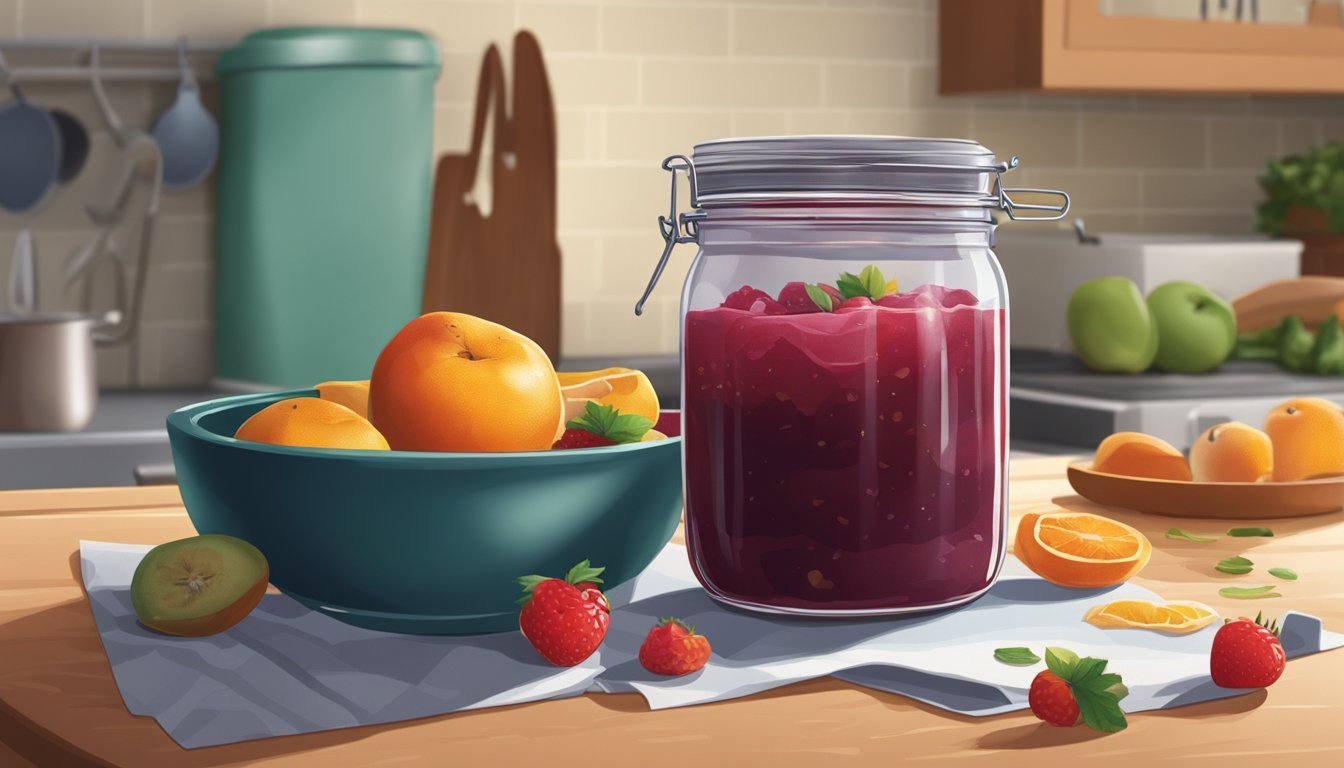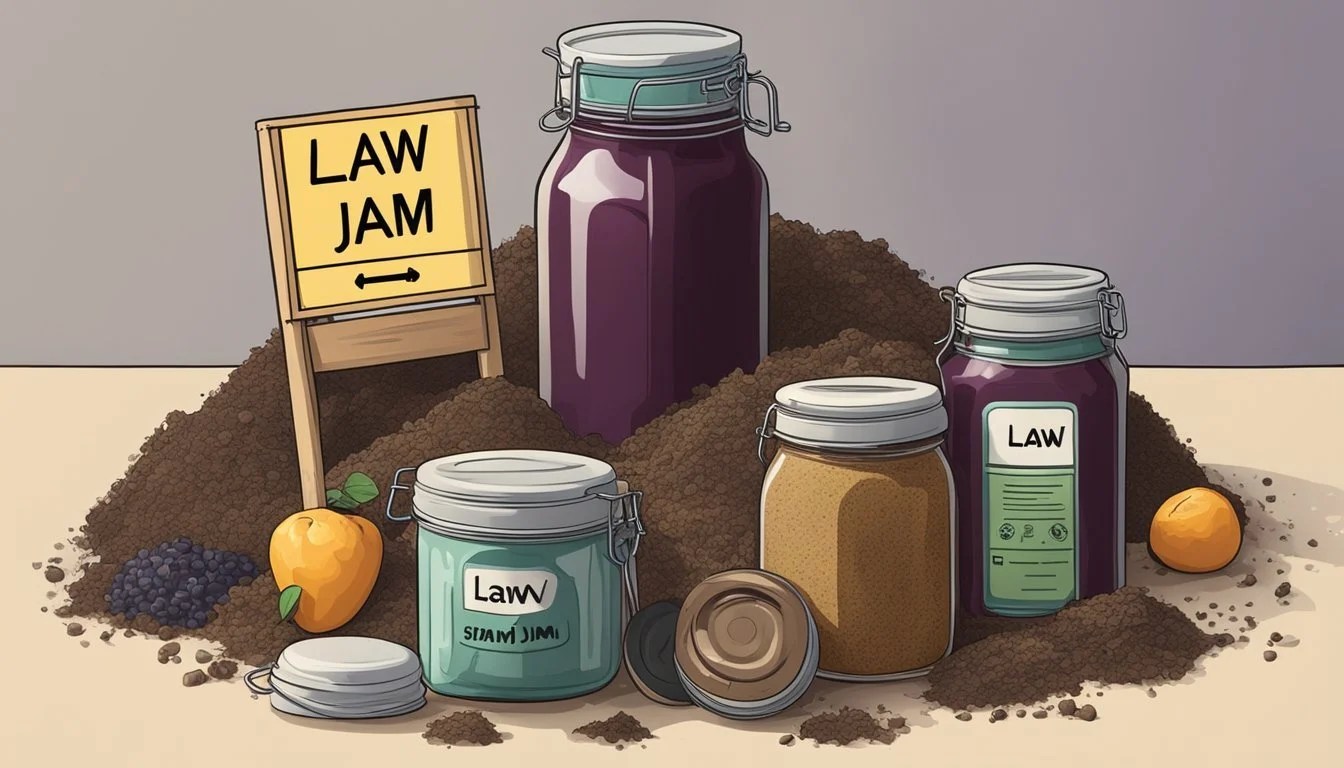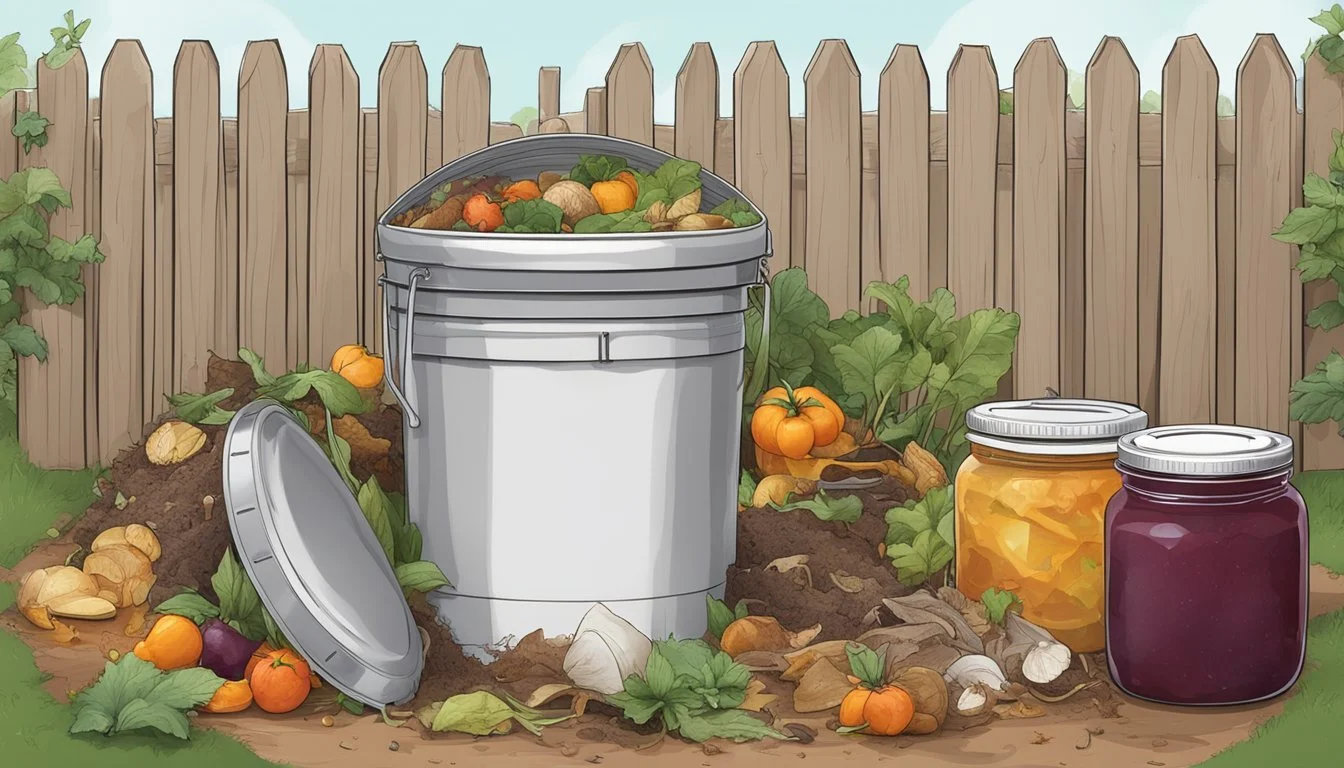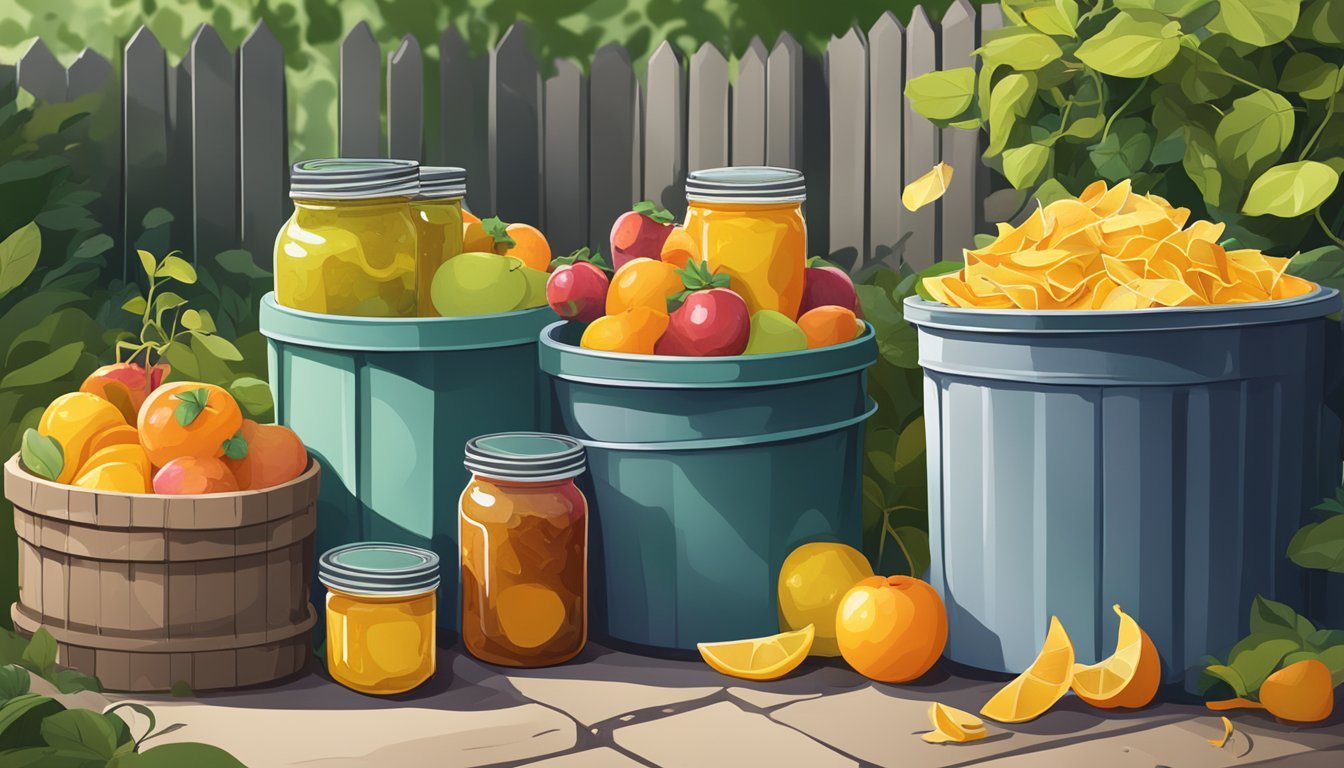Can You Compost Jam?
Unpacking the Do's and Don'ts of Food Waste Recycling
Composting has gained popularity as a natural method for recycling kitchen scraps and reducing waste. As people become more environmentally conscious, they often inquire about the compostability of various food items, including jam. Jam is indeed an organic material, and like other organic waste, it can be broken down by microorganisms in a compost pile. Compost enthusiasts will find that jam, being high in sugars, provides a source of energy that can benefit the composting process.
One should consider, however, the type of jam being added to a compost pile. Organic or homemade jams without artificial preservatives are preferable because they break down more readily. The high sugar content in jam can attract pests, so it is essential to bury it deep within the compost heap and balance it with 'brown' compost materials such as dried leaves, shredded paper, and twigs. These carbon-rich materials help maintain the necessary balance in the compost pile and aid in proper decomposition by managing moisture and providing aeration.
Basics of Composting
Composting is the process of recycling organic matter into nutrient-rich soil, with careful balancing of materials to ensure efficient decomposition.
Understanding Composting
Composting involves the breakdown of organic materials by microorganisms in the presence of oxygen. It is an integral part of reducing waste and combating climate change by diverting organic waste from landfills, where it would release greenhouse gases. The resulting compost is a sustainable source of rich nutrients for gardens, enhancing soil quality and promoting healthier plant growth.
Elements of a Compost Pile
The key components of a compost pile include:
Air (Oxygen): Essential for microorganisms to thrive and break down organic material.
Moisture: Should be evenly distributed to maintain the pile's health without over-saturating.
Carbon (Brown Materials): Dry and woody materials that provide energy for microorganisms. Examples include:
Dead leaves
Branches
Wood chips
Nitrogen (Green Materials): Moist and rich in proteins, these supply the microorganisms with the raw materials to reproduce. Sources include:
Food scraps
Lawn clippings
Coffee grounds
A balanced compost pile should have a carbon to nitrogen ratio of about 30:1. Regular turning of the compost pile ensures even distribution of air and moisture, which aids in proper decomposition and prevents the production of methane, a potent greenhouse gas.
What Can Be Composted?
Composting is a process that transforms organic waste into nutrient-rich soil amendment. This section explores a variety of common household and garden items that can be successfully composted, as well as those that should be excluded to maintain a healthy and efficient composting system.
Common Compostable Materials
Many everyday items from the kitchen and garden can be composted. Below is a list of materials that are typically suitable for a compost pile:
Kitchen Scraps:
Fruit and vegetable scraps (apple cores, banana peels, carrot peelings)
Coffee grounds and filters
Tea bags (remove any staples)
Eggshells (crushed)
Yard Waste:
Grass clippings
Leaves
Plant trimmings
Miscellaneous Organic Waste:
Cardboard (shredded)
Newspaper (non-glossy and shredded)
Sawdust (from untreated wood)
Food items such as jam, being high in sugar, should be added sparingly to prevent attracting pests.
Items to Avoid in Compost
While a variety of kitchen and garden waste can be composted, certain items should be avoided. They can attract pests, cause odors, or introduce diseases and weeds to the compost pile. Avoid composting the following:
Meat Products:
Meat or meat scraps
Bones
Fats and Oils:
Grease and cooking oil
Dairy Products:
Milk
Cheese
Yogurt
To create a balanced compost, it's crucial to mix 'greens,' such as kitchen scraps and 'browns,' like dried leaves, in the correct ratios and turn the pile regularly to aerate it and speed up the composting process.
Special Considerations for Composting
Composting jam requires attention to detail to avoid common pitfalls such as pests and odors. The high sugar content in jam accelerates bacterial growth, impacting the composting process.
Composting Challenges
One must be aware of the increased risk of attracting pests and creating odors when composting food waste, particularly jam, which is high in sugar. This type of waste can decompose rapidly, but the sugar also acts as a strong attractant for rodents and ants. To mitigate this, one could:
Bury food waste deeply within the compost pile.
Maintain a balanced compost ratio of "greens" to "browns" (high-nitrogen to high-carbon materials), ideally aiming for a 1:3 ratio to ensure proper decomposition and odor control.
Controlling Pests and Odors
The introduction of jam into a compost pile can necessitate specific strategies to control both pests and odors:
For Pest Control:
Close monitoring of the compost to ensure it doesn't become a food source for rodents and insects.
Use of compost bins with secure lids or covers can help deter animal intrusion.
For Odor Management:
Regular aeration of the compost pile can help reduce odor by introducing oxygen, which facilitates the breakdown of materials without releasing smelly byproducts.
The addition of carbon-rich materials like dry leaves or sawdust can help balance the compost and absorb excess moisture that often contributes to foul smells.
These considerations are crucial for effective composting, ensuring that the waste decomposes healthily, enriching the soil without undesirable side effects.
Setting Up Your Composting System
Selecting an appropriate compost bin and creating the right conditions are crucial steps to converting organic waste like jam into nutrient-rich compost for your garden.
Choosing the Right Compost Bin
When starting a compost system, the compost bin acts as the cornerstone. One should choose a bin that accommodates their space and volume requirements.
Size: A small garden benefits from a compact bin, while larger spaces may need a bigger one.
Material: Bins can be made from plastic, metal, or wood, each with its own advantages in durability and aeration.
Accessibility: Bins with multiple openings facilitate easier turning of compost.
Maintaining the Right Conditions
A successful compost system hinges on maintaining a balance of moisture and the right mix of carbon-rich (brown) and nitrogen-rich (green) materials.
Moisture: Compost should be kept moist but not waterlogged; a consistency similar to a wrung-out sponge is ideal.
Material Ratio: Aim for a ratio of 1 part nitrogen-rich to 2 parts carbon-rich materials. Nitrogen-rich materials include fruit and vegetable scraps or grass clippings. Carbon-rich materials cover dry leaves, twigs, or shredded paper.
Aeration: Turning compost regularly ensures proper aeration, helping to speed up the decomposition process and preventing odors.
Composting Specific Food Items
In the realm of composting, diverse food items have varying impacts on the compost pile's health and balance. Proper knowledge of how to compost specific foods can ensure a nutrient-rich end product.
Composting Fruits and Jams
Composting fruits is generally straightforward as they are rich in nitrogen, which is essential for the composting process. They should be considered "green" materials and can provide necessary nutrients to the soil. Jam, as a fruit-based product, is compostable because of its organic nature. However, it should be added to the compost pile in moderation to avoid attracting pests with its high sugar content.
Fruits: Apples, bananas, berries, and other fruits can be added directly to the compost.
Jams: Due to sugar content, they should be mixed thoroughly with "brown" materials such as leaves and twigs.
Items Requiring Special Attention
Certain items require special consideration before being added to a compost pile to prevent potential issues such as pests, odors, or the introduction of pathogens.
Spices and Herbs: These can be composted, but should be done so sparingly, as some may contain oils that can affect the composting organisms.
Coffee Grounds: They are an excellent addition to compost, providing nitrogen and a boost to the decomposition process.
Filters: Most paper filters are compostable but ensure they're unbleached and free of plastic.
Tea Bags: These can be composted, but one should remove any staples and confirm the bag material is not synthetic.
Benefits of Composting
Composting transforms waste into a valuable resource, simultaneously reducing environmental impact and enhancing garden and soil health.
Environmental Impact
Composting organic materials, like jam, contributes to waste reduction by diverting items from landfills. In a landfill, organic waste generates methane, a potent greenhouse gas. However, composting this material reduces methane production and lowers carbon dioxide levels in the atmosphere. Moreover, it conserves water by retaining moisture in the soil, preventing soil erosion.
Waste Reduction: Converts kitchen scraps and yard waste into compost, reducing garbage volume.
Greenhouse Gas Mitigation: Decreases methane emissions from landfills.
Water Conservation: Compost assists soil in retaining moisture, reducing the need for frequent watering.
Garden and Soil Enrichment
Compost acts as a soil amendment, enriching the garden's soil with nutrients. This organic material improves soil structure, making it more porous and better able to hold nutrients and water, which directly benefits plant growth.
Soil Amendment: Improves soil structure and health, which facilitates plant root growth.
Nutrient-Rich: Supplies essential nutrients to plants, reducing the reliance on chemical fertilizers.
By incorporating compost into garden maintenance routines, gardeners can build healthier, more productive gardens and contribute to a more sustainable ecosystem.
Troubleshooting Common Compost Issues
In the journey to creating nutritious compost, enthusiasts frequently face various challenges. Thorough understanding and implementation of fixes can ensure a healthy composting process.
Identifying Common Problems
Moisture Levels: A compost pile requires appropriate moisture for decomposition, but excess water can lead to soggy conditions, unpleasant odors, and a slowdown in the composting process. Conversely, too little moisture will impede the activity of beneficial organisms.
Air Circulation: Adequate aeration is crucial; without it, compost can become compacted, reducing oxygen levels and causing anaerobic bacteria to thrive, which slows down decomposition and creates foul smells.
Carbon to Nitrogen Ratio: The balance between carbon-rich 'browns' and nitrogen-rich 'greens' must be maintained. An excess of carbon can stall the composting process, while too much nitrogen can lead to a smelly, wet pile.
Temperature: The internal temperature of a compost pile is a good indicator of microbial activity; a pile that's too cold may not be decomposing effectively, whereas excessive heat could kill beneficial microbes.
Finished Compost: Unfinished compost can contain harmful pathogens or weed seeds. It's essential to recognize when compost is mature and ready to use, which is typically dark, crumbly, and has an earthy smell.
Solutions to Enhance Composting Process
Moisture Management: To adjust moisture levels, homeowners can add dry materials like straw to absorb excess water or sprinkle water over the pile during dry conditions. Covering the pile can also help maintain ideal moisture.
Improving Aeration: Turning the compost pile regularly encourages air circulation. If the pile is too damp or dense, adding bulky, coarse materials such as small sticks or shredded newspaper can improve its structure and air flow.
Balancing Input Materials:
For high Carbon: Incorporate more 'greens' like vegetable scraps or grass clippings.
For high Nitrogen: Mix in 'browns' such as leaves, sawdust, or cardboard.
Maintaining Temperature:
Too Cold: Insulate the pile with straw or leaves and ensure it's large enough to retain heat.
Too Hot: Increase the frequency of turning to disperse heat and incorporate more 'browns' to moderate the temperature.
By promptly addressing these common issues, one can maintain a healthy compost pile, transforming kitchen and garden waste into rich, finished compost.
Advanced Composting Techniques
Advanced composting techniques utilize specific methods to enhance the natural decomposition process, improving efficiency and end-product quality. These techniques often involve controlled conditions to optimize microbial activity, which in turn benefits soil health and plant growth.
Vermicomposting
Vermicomposting harnesses the power of worms, typically red wigglers, to break down organic waste into nutrient-rich compost. These worms consume materials such as vegetable scraps and shredded paper, leaving behind castings which are an excellent amendment for soil. Bacteria within the worms' gut aid the composting process, contributing to a microbe-rich end product. This method is efficient and can be maintained indoors or outdoors, integrating nature's recyclers into waste management.
Materials for Vermicomposting: Vegetable scraps, fruit peels, coffee grounds, eggshells, shredded newspaper.
Maintenance: Keep the bin moist, provide bedding, and avoid overfeeding.
Hot Composting
Hot composting accelerates decomposition by creating an environment favorable for heat-loving microbes. They manage a balance between carbon-rich and nitrogen-rich materials to raise the compost pile's temperature to at least 55°C (131°F). This technique results in a faster breakdown of organic matter and produces high-quality compost within weeks. Regular maintenance is required to ensure adequate aeration and moisture for the composting pile. This method also helps in reducing pathogens and weed seeds in the compost.
Key Elements of Hot Composting:
Aeration: Turn the pile regularly to introduce oxygen.
Moisture: Keep the pile as damp as a wrung-out sponge.
Balance: Maintain a carbon to nitrogen ratio of 30:1.
Temperature: Monitor to ensure the pile remains between 55°C and 65°C.
Composting and the Law
In the context of environmental law and waste management policies, composting, specifically the composting of jam, intersects with government regulations meant to reduce landfills, manage trash, and encourage the recycling of organic matter within households and communities.
Regulations and Guidelines
Regulations around composting can vary significantly from one region to another. They often aim to reduce the amount of organic waste—such as food scraps and yard clippings—entering landfills. Composting jam, as part of household waste, must comply with these laws which may dictate aspects such as:
Placement and maintenance of compost bins: Regulations may be in place that govern where compost bins can be located on a property and how they must be maintained to avoid nuisances or health hazards.
Acceptable compost materials: Certain jurisdictions detail what organic matter is acceptable for composting, and jam might be categorized under specific rules due to its high sugar content.
Community health standards: Laws often require that composting practices do not attract pests, which can be a concern when composting sweet substances like jam.
Legal consequences can arise from non-compliance, including fines or other penalties, so individuals are advised to seek out and adhere to their local guidelines.
Community Composting Initiatives
Community composting initiatives represent collaborative efforts, often supported or regulated by law, to manage organic household waste at a communal level. Such initiatives:
Promote education and participation: They typically aim to educate residents about the benefits of composting and encourage participation in reducing landfill use.
Provide infrastructure: Communities often establish central composting facilities to manage larger quantities of organic matter, including items like jam, which may be harder to compost at home.
Legal framework: These initiatives operate within a legal framework that may include incentives, subsidies, or mandatory participation laws.
For example, in California, a new composting law was phased in starting January 1, requiring residents to separate organic waste, highlighting community composting as a key strategy in the state's waste reduction efforts.
Frequently Asked Questions
This section addresses common queries about composting jams and optimizing compost ratios for a successful kitchen and garden waste management system.
Can You Compost Jam and Similar Foods?
One can indeed compost jam, as well as other fruit preserves like jelly, due to their organic nature. However, it is important to be mindful of the high sugar content in these foods, which can accelerate bacterial growth and possibly unbalance the compost pile. Therefore, they should be added in moderation. It's preferable to compost homemade or organic jams that have fewer additives, to maintain a healthier compost.
How to Optimize Your Compost Ratio?
To ensure a healthy composting process, maintaining an appropriate balance between green (nitrogen-rich) and brown (carbon-rich) materials is vital. The recommended composting ratio is approximately 1 part greens to 3 parts browns. Jam, being a green material due to its sugar content, should be used sparingly within this ratio. Too much can make the compost too wet and hinder aeration. Balancing jam with materials like dry leaves, straw, or shredded paper can help maintain an optimal compost ratio for a thriving garden.
Conclusion
Jam is classified as organic material and is acceptable for use in compost piles. It is regarded as a "green" compost ingredient, which means it's rich in nitrogen necessary for the composting process. When composting jam, individuals contribute to sustainability efforts by reducing waste and recycling nutrients back into the soil.
Composting Tips:
Mix Well: Combine jam with "brown" material, such as leaves and twigs, to balance the compost pile.
Moderation: Due to its sugar content, jam should be added in moderate amounts to prevent attracting pests.
Homemade or Organic: Preferring homemade or organic jams can be beneficial as they usually contain fewer additives, ensuring a smoother composting process.
Maintenance: Regularly turn the compost to maintain proper aeration and moisture levels.
Composting jam is a simple way to reduce food waste and support a healthy, nutrient-rich compost pile. It contributes to an eco-friendly garden and promotes a cycle of sustainability.











